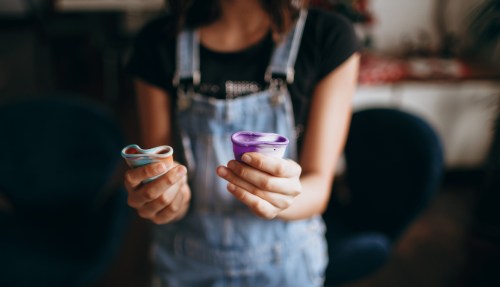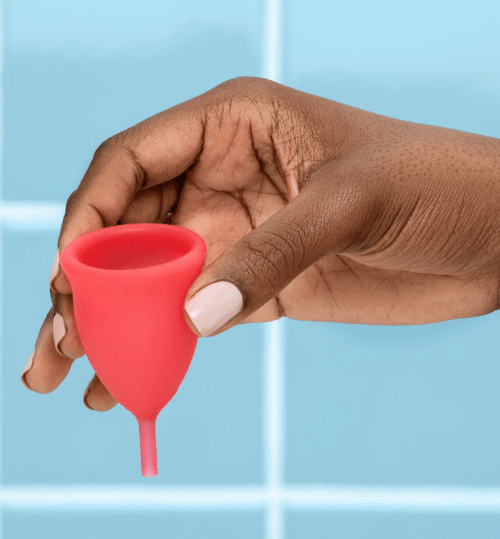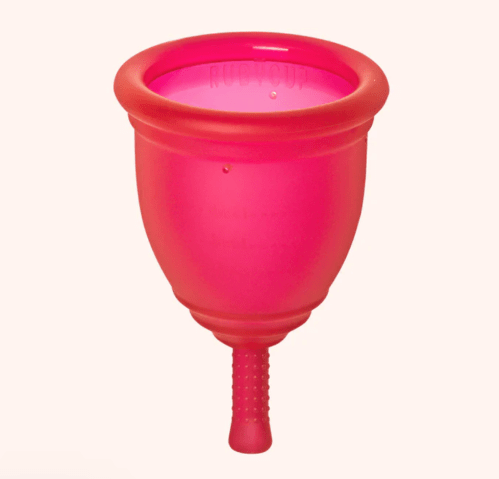Our editors independently select these products. Making a purchase through our links may earn Well+Good a commission
I Traded Tampons for Menstrual Cups for 3 Months, and I Am Sold—Here’s What They’re Actually Like To Use
Learn what it's like to use the best menstrual cups—long-lasting protection and peace of mind, no tampons necessary.

Although I’ve long been sick of the period tax (and the waste), I’d never really considered an alternative to tossing tampon after tampon. But recently, various women in my life told me they were trying menstrual cups and discs. In particular, my dear friend and adventure partner sung the cups’ praises: She used hers while biking, hiking, and skiing during her period.
Experts in This Article
global brand manager, Foreo
board-certified OB/GYN and co-author of The Vagina Book: An Owner’s Manual for Taking Care of Your Down There
OB/GYN and an ambassador for The Hello Cup
If so many people in my life were making the switch, was I missing out by being stuck in my tampon rut? I decided it was time to try out a few of the best menstrual cups for myself.
Menstrual cups are reusable feminine hygiene products. These flexible, bell-shaped cups—typically made of medical-grade silicone—are inserted into the vagina, and instead of absorbing your period blood like a pad or tampon does, they collect the blood in the cup. After 12 hours, you remove the cup, pour out the blood, give the cup a cleaning, and put it back in. Some brands say they can last up to 10 years. (Though there are also some disposable menstrual cups available.)
If this sounds like a newfangled Gen Z invention, know this: The first usable commercial cup was actually brought to market all the way back in 1937, but only recently has the idea become more mainstream.
If so many people in my life were making the switch, was I missing out by being stuck in my tampon rut?
I won’t lie—starting this chapter felt intimidating. I decided that I would try three different brands over the course of three cycles to give menstrual cups a solid try. To figure out which brands would make most sense for me, I meandered over to Amanda Hearn’s period education platform Put A Cup In It—and very quickly learned it’s not all one-size-fits-all-vaginas. Fortunately, Hearn has created the Menstrual Cup Quiz you can take to find out which cups to try. I am 36 (hello, mid-thirties!), have vaginally delivered a baby, and have a regular-to-light flow. Yes, these details matter when finding the right cup for you.
The results: The Saalt Soft and Ruby Cup were my top recommendations as the best menstrual cups for me. I also tried the Honey Pot. Here’s how it went.
Learning how to use a menstrual cup
Because I was a newbie, I practiced inserting the cup before my period actually started so I wouldn’t be caught off guard trying a new contraption when I was already bleeding. (I highly recommend learning how to insert a menstrual cup before your flow begins.)
After sanitizing the cup (boil for three to five minutes after purchase and to start each cycle), I tried my luck. The easiest method to get a period cup into your vagina is the U-shaped fold. With clean hands and a sanitized cup, hold the cup between your fingers and fold it in the shape of a “U.” You can then insert it rim-side first, almost like you would with a tampon without an applicator. Once inside, the cup returns to its cylinder shape and creates an airtight seal.
This was easier said than done, and it took practice to get right. I knew I did it wrong at first because 1) I could feel a dull pressure from the cup, and 2) the stem was sticking out. That couldn’t be right.
I tried again, and after getting the kinks of user error out, the cup was fully inserted into my vagina and the stem was no longer visible—this left a much more comfortable feel that was as natural as a tampon, to my surprise.
Month 1: Saalt Soft Cup
I started this cup journey with the Saalt Soft Cup, regular size ($29). This size cup is recommended for higher cervixes and post-childbirth. Celebrated for its comfortable feel, Saalt Soft is a pro first-timer’s cup. I was concerned it would jab or I’d feel pressure inside, but once I got it in the right position, it fit easily.
The cup has the capacity of four tampons. But I was convinced it would leak and felt nervous to go about daily life. I had a hike with friends planned on what would have been considered a heavy flow day, so I also used a panty liner to be safe.
Spoiler: You really can wear the cup and live your life. It stayed in place the entire time and after two intentional pit stops to check for leaks, I was pleasantly surprised to find none.

Saalt Soft Cup — $29.00
Sizes: 2 (regular and small)Materials: medical-grade silicone
Lasts: up to 10 years
Pros:
- Comfortable
- Holds the capacity of four tampons
- Easy-to-follow directions
Cons:
- Some reviewers report it can be difficult to remove
After about eight hours (you can go for 12, but I was nervous and wanted to make sure I didn’t push its limits), I tried my luck at removing the cup without leaving my bathroom looking like a murder scene. Period cups aren’t meant to just be yanked out like a tampon. Instead, to remove a menstrual cup, with clean hands, you must reach inside and break the seal of the cup before gently pulling it out. I read horror stories about cups getting stuck, so my nerves were on edge. But, the gentle squeeze to break the seal worked for me, and the cup came out. I emptied it, and then I used the Saalt Cup Wash ($13)—which claims to help maintain a healthy pH—to clean it before giving it another insert.
My take: This was a wonderful beginner cup to experience my first month of nixing tampons. The website’s directions are helpful and easy to follow. Familiarize yourself with the process before your period and don’t get discouraged with it doesn’t feel comfortable the first time you insert it.
Month 2: The Honey Pot
The Honey Pot Menstrual Cup ($24) is sturdy, easy to use, and feels super substantial without leaving you aware you are using the cup. Feeling a little more confident on month two, I took other users’ advice and trimmed down the stem, so it wasn’t as long. This can be done for any cup with a straight stem to ensure maximum comfort. Some cups, however, have a loop on the end for easy gripping. Once cut, this meant the cup (I was trying size 2) felt a little higher inside my vagina. Note that if you do feel a poking sensation, you might have inserted it incorrectly.
During this round, I was in peak summer mode and tested my luck swimming. No leaks and no discomfort. I realized my concerns were mostly mental. I was too aware of the cup only because I was nervous about leaks poolside, but once I became more confident in my cup-inserting skills, I stopped thinking about it and relaxed.

Honey Pot Menstrual Cup — $24.00
Sizes: 2Materials: medical-grade silicone (free of latex and phlalates)Lasts: Up to one year
Pros:
- Sturdy
- Easy to use
Cons:
- Some reviewers report the rim feels rough when inserted
When it came time to remove The Honey Pot, I used the squat method to relax my pelvic floor muscles. I gave it a squeeze and slight twist and felt the seal break.
My take: I liked the sturdy feel of this cup. It gave me the confidence to step out of my comfort zone and do more while on my period.
Month 3: The Ruby Cup
What pushed me to try the Ruby Cup ($33) is the company’s mission. For every cup purchased, they donate a cup to a person without access to period products. To date, that’s more than 140,000 cups, which has saved more than 14 million kilograms of plastic in tampon usage. While the price tag is a little higher than the other two, the donation made the extra money spent more than worth it.
Beyond the mission, the Ruby Cup made me feel like a seasoned pro. The size medium inserted easily, and just like the other two, the material was firm but comfortable. What set this cup apart was the easy-grip stem: It has elevated pumps that make grabbing it without looking simple. I didn’t feel the need to trim this one down at all, because it was such a cinch to remove after use.

Ruby Cup — $33.00
Sizes: 2 (small and medium)Materials: medical-grade siliconeLasts: up to 10 years
Pros:
- A cup gets donated with every purchase
- The easy-grip stem makes removal easy
Cons:
- Can take some time to get the hang of proper insertion
I had one heavier than normal day during this cycle and cleaned the Ruby Cup midday while at the office (I had my cleaning wash in my purse). I was a bit concerned how this would go, whereas for the previous two I was great for 12 hours. But it was a breeze. I removed, cleaned, and reinserted the cup in just five minutes.
My take: With a great mission, it’s just an added bonus that this cup is a cinch to remove.
Frequently asked questions
How do you know when your menstrual cup is full?
According to Dame period care, there are a few tell-tale signs that your cup is full. The cup might start to feel heavy and your pelvic muscles will tire a bit form holding it up. You might start to experience some leakage. And you might also start to feel some discomfort as the cup shifts down in your vagina under the extra weight.
As Amandine Pranlas-Descours, former global brand manager of feminine care company Intimina, previously told Well+Good about using menstrual cups, once you start using a cup regularly, you’ll begin to intuit exactly when it’s time to take it out.
Can you feel a menstrual cup when you walk?
If you’ve inserted a menstrual cup correctly, it should feel no different than a tampon. Meaning, other than maybe getting a dull sensation when it’s fuller, you really shouldn’t feel it—especially not during day-to-day activities like walking.
What are the disadvantages of menstrual cups?
Menstrual cups are clearly more environmentally-friendly than disposable tampons or pads that fill up your bathroom trash can. They are also more wallet-friendly, since one cup can last several years.
That said, there is a learning curve associated with using menstrual cups and finding the right fit. “Each brand has a different design, and every vagina and cervix is a different shape,” Jennifer Conti, MD, board-certified OB/GYN and co-author of The Vagina Book: An Owner’s Manual for Taking Care of Your Down There, previously told Well+Good. “If the cup is too small, you’ll have leakage. If it’s too big, it might be uncomfortable.” In particular, there’s a potential for mess when you empty it, which is why experts recommend that you take it out while hovering over the toilet and ideally at home, so that you have easy access to a sink for washing your hands and rinsing the cup.
And while you can wear a menstrual cup with an IUD, there is a chance it could get caught on the IUD’s string, causing the device to dislodge. Talk to your medical provider if you plan on wearing both—they may cut the IUD’s string short to avoid problems, according to Nicole Alicia, MD, an OB/GYN and an ambassador for The Hello Cup.
My takeaway
One big realization for me was how much of my nerves surrounding menstrual cups were just based on a societal pressure to keep periods a secret. The dreaded leak felt like a nightmare—I’m talking flashbacks to middle school fears of a stain on your jeans. But periods are a part of life. The cup, I found, actually helped me normalize something that’s been in my life for 20 years. I hadn’t expected this method of period management to be so empowering.
After three months, a little mental work, and a new sense of period empowerment, I can officially say I am a cup convert.
Sign up for the Well+Good SHOP Newsletter
Get exclusive deals on wellness, beauty, fitness, and food products that have been hand-picked by our editors.
Got it, you've been added to our email list.









